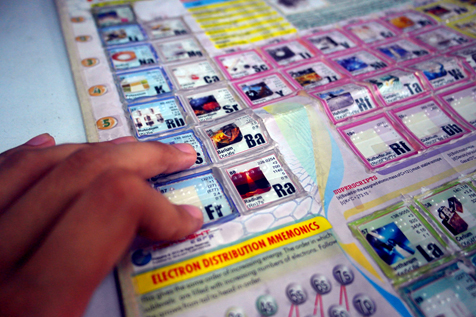
By JAKE SORIANO
Nine-year-old Sebastian walked into the covered court with a medal in his hand.
“Kagabi niya pa hawak iyan. Tapos sabi niya sa kapitbahay namin, ‘May medal ako (He has been holding on to that medal since last night. He proudly showed it off to our neighbors)!’” explained his mother Rosalina Guelas, referring to the glittering proof of her son’s victory in a sports fest for people with visual impairment.
Normally shy, Sebastian was quick to answer when asked which sport he got the medal for. “Takbo! Fifty-meter yun (Running. A 50-meter run),” he said, beaming.
He was still an infant when he lost both eyes to retinoblastoma, a malignant tumor of the eye commonly found in children.
“He is wearing artificial eyes now. We tried chemotherapy for six months thinking it would save one eye, but he eventually lost both,” Guelas said.
Sebastian is now in Grade 2 at the Rosa Susano Elementary School in Novaliches, Quezon City. But instead of attending special education (SPED) for children with disabilities exclusively, he is also enrolled in a regular class along with other children without disabilities.
The Department of Education (DepEd) aids schools with their transition programs from SPED to inclusive classes, a crucial step for kids with disabilities who get to attend school like Sebastian.
“Okay naman (He does well),” his mother said.
She accompanies Sebastian every day to school and reads for him what teachers write on the board. “Siya yung susulat, Tapos ire–review ng SPED kung ano iyong nagawa niya sa regular class (He writes down what I dictate. The SPED teacher would then review his progress in the regular class).”
This inclusive education program is an initiative of the nonprofit organization Leonard Cheshire Disability Philippines Foundation. Its goal is to support the enrollment and retention of children with disabilities from ages 5 to 12 in primary schools in Quezon City, Caloocan and Valenzuela in Metro Manila and Atimonan in the province of Quezon.
Getting a child with disability to attend school is not easy, said Guelas.
“Another challenge naman kasi naga-aral na siya. So kailangan mo siyang tutukan (This is another challenge because he is now in school. And you really need to pay him close attention), she said.
But Guelas said this is a relief compared to what she and her family have gone through before. She herself had lost one eye to a tumor, but it was her son’s time at the hospital that was toughest for her.
“Yung parang susuko ka na. Pero mamaya-maya may darating na tulong. Iyon ang hindi ko makalimutan. (You really feel like giving up, but then unexpected help comes along. That’s the part I will never forget),” she said.
Inclusive education
Last week Rosalina and Sebastian attended a family day activity at the Bagong Pag-asa Elementary School in Quezon City. Like Rosa Susano Elementary, the school also works with Leonard Cheshire Foundation in implementing inclusive education.
During the family day, some 30 other children with disabilities, along with their parents and teachers, sang, danced and cheered for their respective schools.
In his remarks, Bagong Pag-asa school principal Meneleo Meneses said that the transition from SPED to inclusive classes is “very important.”
“It teaches SPED learners to be independent, and equipped with the necessary competencies and skills to face the challenges outside the four corners of the classroom.”
“Hindi na po pwede na sila at sila pa rin (SPED learners cannot be interacting only with SPED learners),” he explained.
“Kasi paglabas po nila ng paaralan, nakikisalamuha po sila sa pamayanan (Because when they leave the school every day, these children also interact with their communities).”
Children with disabilities form a large percentage of the total persons with disabilities (PWD) population in the Philippines.
“For every five PWD, one (18.9 percent) was aged 0 to 14 years,” noted the Philippine Statistics Authority in its 2010 census.
But the Leonard Cheshire Disability Philippines Foundation says problems persist despite free education in public schools which result in low enrollment and retention rates of children with disabilities.
“Many are unable to attend school due to the high cost of health and rehabilitation services, transportation issues, negative attitude, lack of trained teachers, and inaccessibility of school facilities,” it said.
In the 16th Congress, at least 13 bills related to special education have been filed in the House of Representatives and 11 in the Senate.
Guelas said her efforts to take Sebastian to school every day are all because of one desire.”Gusto lang namin makapag-aral (We just want to see him go to school),” she said.
Looking at her son and his medal, she added, “Parang ngayon pa lang ako nakakahinga (It’s only now that I feel some sort of relief).”
Asked how he is doing in school, shy Sebastian answered, “Okay naman.”
“Madalas nga rin sya tawagin sa recitation (He gets called a lot in recitation),” Rosalina interjected. “Favorite ang Makabayan (His favorite subject is Makabayan).”

